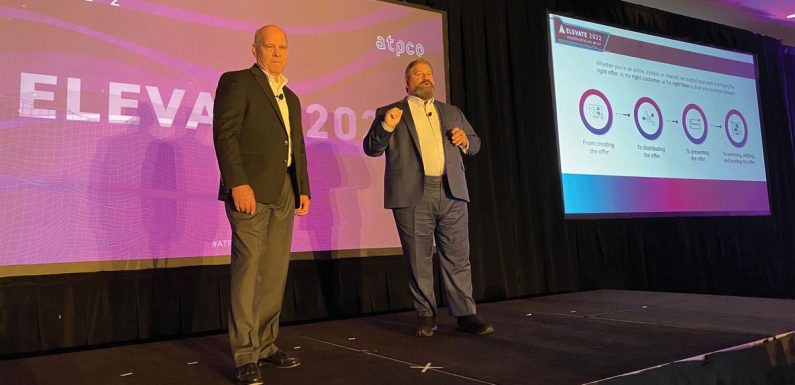
ARLINGTON, Va. — A variety of newly planned initiatives from ATPCO will lay the groundwork for a rapid expansion of dynamically generated airline fare offerings in the coming years.
But even Alex Zoghlin, CEO of the airline-owned tech developer and fare-filing repository, concedes that moving the needle fast won’t be easy.
Zoghlin used the stage at the company’s annual Elevate conference here on Oct. 11 to announce its goal of building the technological framework for 80% of flight offers to be dynamically generated by 2026. Presently, approximately 15% of fare offers are dynamic, ATPCO estimates.
ATPCO defines dynamic offers as those in which either the price or the ancillary options put forward in response to a flight query is modified or created at the time of the query.
Dynamic fares differ from the historical airline pricing system, in which carriers respond to flight searches from a limited selection of fares they have already filed with ATPCO, which has long served as the repository for traditional airline fare filings.
Sharing the stage with Zoghlin, chief strategy officer Tom Gregorson said he believed the widespread delivery of dynamically generated fare offerings could lead to a second fundamental shift in what U.S. flyers look for when they search for flights.
Prior to deregulation of the U.S. airline industry in 1978, he said, travelers looked almost exclusively at airline schedules in choosing a flight, as prices were set by the government. Since then, price and schedule have been the two main factors.
In a world of mostly dynamic offers, Gregorson said, flyers will begin looking more closely at the amenities they’d like on their flights. And airlines that are merchandising effectively will be able to present travelers with the most appealing offerings.
And benefits will also flow back to airlines, said Gregorson, citing a 2019 study from consulting firm McKinsey saying that airlines could realize up to $40 billion in new value annually by 2030 via widespread implementation of such merchandising.
Speeding up dynamic adoption
Still, Zoghlin acknowledged that despite ATPCO’s plan to create the framework for it, no matter what it does, dynamic offers won’t make up 80% of all offers by 2026.
“It’s not going to happen,” he said.
ATPCO, though, laid out a variety of measures it will commence in hopes of speeding adoption.
One will seek to resolve servicing and settlement challenges that often accompany the sale of offers made outside the traditional ATPCO fare-filing system.
Under the promised solution, called airline order posting, carriers would be able to send such an order to ATPCO, which would transform it to be compatible with data systems using existing settlement rules. That data would then be pushed to any systems the airline uses to support refunds, reissues or passenger revenue accounting functions.
Travel agencies wouldn’t have to make any changes to their back-end systems to service such sales, Gregorson said. And airline order posting would also free airlines from having to create their own workarounds to service or settle orders made from dynamically generated offers.
Patrick Healy, director of sales and distribution for the Scotland-based automated fare-filing creator Volaro, said that airline order posting will be a game-changer if ATPCO can pull it off.
“It will lead to millions more fares,” he said.
ATPCO says it currently has more than 306 million fares in the market at a given time.
Spotlight on NDC
Still, the ATPCO executives made clear their understanding that dynamic pricing won’t rapidly grow without much faster uptake by airlines and travel agencies of NDC technology, which is typically needed to create a dynamic offer.
It’s a view shared by Norm Rose, Phocuswright’s senior technology and corporate market analyst.
- Related: IATA says 10% of travel agency air sales are via NDC
Rose said that the corporate travel market especially hasn’t found NDC to its liking: Some seven years after IATA published its first NDC standard, he said, less than 1% of the corporate market has adopted NDC distribution technology.
“This solution is fine for individual travelers,” Rose added. “But this does not solve the problem for the corporate travel market right now, and, in fact, it complicates it.”
At Elevate, ATPCO laid out two efforts it will initiate in order to address NDC adoption.
First, the company said it would shutter its NDC Exchange as a commercial enterprise and begin providing the exchange’s source code free of charge to the industry.
NDC Exchange has been a platform that aggregates and facilitates NDC-enabled connections between airlines and external travel sellers, including travel agencies — one of what Zoghlin said are approximately 50 such platforms that are currently competing in the market.
Going forward, ATPCO will make the technology it developed for the exchange open to airlines and travel agencies to be used in their own NDC development.
Gregorson also said that ATPCO intends to create a design group, peopled by experienced NDC developers, to troubleshoot implementation challenges. For example, the group could tackle the ongoing inability of NDC to process the net fares used by ticket consolidators.
Still, Rose has other doubts. “I’m concerned that the airlines don’t have a clear understanding of the needs of the traveler,” he said.
Source: Read Full Article









